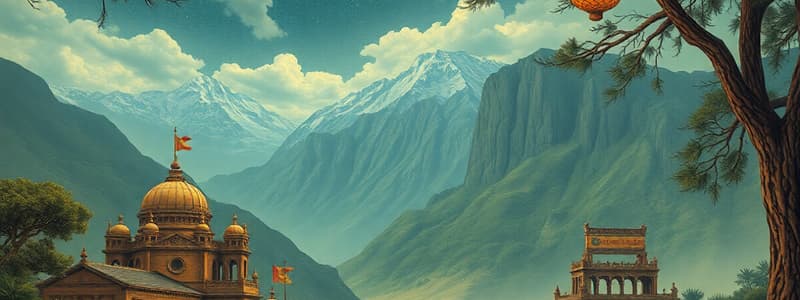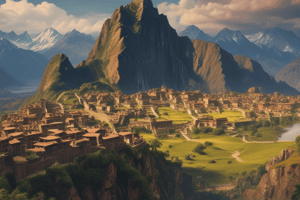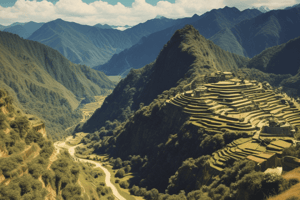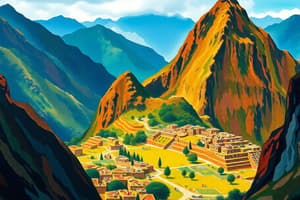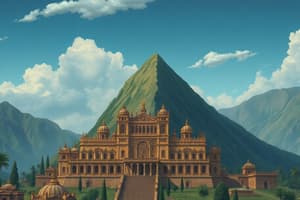Podcast
Questions and Answers
Which geographic feature most significantly aided the Inca Empire in defense and presented challenges to its expansion?
Which geographic feature most significantly aided the Inca Empire in defense and presented challenges to its expansion?
- The Amazon Rainforest, hindering eastward expansion.
- The Pacific Ocean, limiting naval capabilities.
- The Andes Mountains, providing a natural barrier. (correct)
- The extensive river systems, causing logistical issues.
How did the Inca's use of the 'Mit'a' system directly contribute to the empire's infrastructural development and maintenance?
How did the Inca's use of the 'Mit'a' system directly contribute to the empire's infrastructural development and maintenance?
- By promoting trade and economic growth through specialized labor divisions.
- By fostering voluntary participation in community projects, boosting morale.
- By allowing skilled artisans to focus solely on crafting luxury goods.
- By ensuring a constant labor supply for constructing roads and terraces. (correct)
If an archaeologist discovers a complex network of aqueducts in a newly found Inca settlement, what inference could they reasonably make about the settlement's priorities?
If an archaeologist discovers a complex network of aqueducts in a newly found Inca settlement, what inference could they reasonably make about the settlement's priorities?
- The settlement was primarily focused on textile production.
- The settlement was strategically positioned for maritime trade.
- The settlement placed a high value on efficient water management. (correct)
- The settlement had a strong emphasis on precious metal mining.
Which statement accurately connects a specific Inca innovation to its primary function within the empire?
Which statement accurately connects a specific Inca innovation to its primary function within the empire?
How did the role of the 'Sapa Inca' differ from that of leaders in other contemporary civilizations?
How did the role of the 'Sapa Inca' differ from that of leaders in other contemporary civilizations?
Considering the geographical distribution of the Inca Empire, which present-day country was LEAST influenced by Inca civilization?
Considering the geographical distribution of the Inca Empire, which present-day country was LEAST influenced by Inca civilization?
What was the purpose of the 'Chimus' in relation to the Inca Empire?
What was the purpose of the 'Chimus' in relation to the Inca Empire?
If a 'Chaski' is carrying a 'Quipu' from a distant region to Cusco, what type of information is he most likely transporting?
If a 'Chaski' is carrying a 'Quipu' from a distant region to Cusco, what type of information is he most likely transporting?
Flashcards
Peru
Peru
The heart of the Inca Empire; home to Cusco and Machu Picchu.
Pachacuti
Pachacuti
Inca emperor who expanded the empire significantly in 1438.
Andes Mountains
Andes Mountains
High-altitude mountain range providing natural defense for the Inca Empire.
Terraces
Terraces
Signup and view all the flashcards
Sapa Inca
Sapa Inca
Signup and view all the flashcards
Mit'a
Mit'a
Signup and view all the flashcards
Inti
Inti
Signup and view all the flashcards
Quipu
Quipu
Signup and view all the flashcards
Study Notes
- The Inca Empire was the largest in pre-Columbian America.
Countries of the Inca Empire
- The empire covered parts of six modern-day countries.
- Peru was the heart of the empire, home to Cusco and Machu Picchu.
- The northernmost region of the empire was Ecuador.
- Only the southern region of Colombia was influenced by the Incas.
- Bolivia included many key Inca settlements.
- The empire extended into northern Chile.
- The Inca controlled parts of northwest Argentina.
Important Dates
- The Inca civilization began in the Andes in the 1200s.
- In 1438, Pachacuti significantly expanded the empire.
- Spanish conquistador Francisco Pizarro arrived in 1532.
- The Inca Empire fell in 1533 after Atahualpa was captured and executed.
- Final Inca resistance ended at Vilcabamba in 1572.
Physical Geography
- The geography of the Inca Empire was challenging and beneficial.
- The Andes Mountains provided natural defense due to their high-altitude, rugged terrain.
- The Amazon Rainforest was a dense jungle bordering the eastern part of the empire.
- The Pacific Ocean formed the western boundary.
- Terraces were stepped agricultural fields built on mountain slopes for farming.
- The Inca Road System consisted of over 24,000 miles of roads connecting the empire.
- Machu Picchu was a famous Inca city possibly used as a royal estate or religious center.
- The Intihuatana was a stone used as a sun calendar to track the seasons.
Key Vocabulary
Government & Society
- The Sapa Inca was the emperor, considered a god.
- An Ayllu was a family clan or extended kin group.
- Mit’a was a system of mandatory labor service to the empire.
- Dynasty refers to a powerful ruling family that stays in control for generations.
Religion & Culture
- Inti was the Sun God, the most important deity.
- An Oracle was a priest/priestess who communicated messages from the gods.
- A Huaca was a sacred object or location in Inca religion.
- The Chimus were a mother culture of the Inca Empire, influencing their traditions.
Technology & Communication
- Chaskis were messengers who ran long distances to deliver messages.
- Quipu was a knotted string system used for counting and record-keeping.
- An Aqueduct is a structure used to transport water, similar to irrigation.
- Intihuatana was an Inca Sun Calendar used for astronomy.
Animals & Farming
- A Beast of Burden is an animal used for carrying loads (e.g., llamas).
- Terraces were stepped agricultural fields carved into mountains for farming.
Studying That Suits You
Use AI to generate personalized quizzes and flashcards to suit your learning preferences.
Description
Explore the Inca Empire's vast reach across six modern countries, including Peru, Ecuador, and Chile. Learn about the empire's key dates, from its rise in the 1200s to its fall in 1533. Discover how the Andes Mountains shaped the empire's defense and agriculture.
